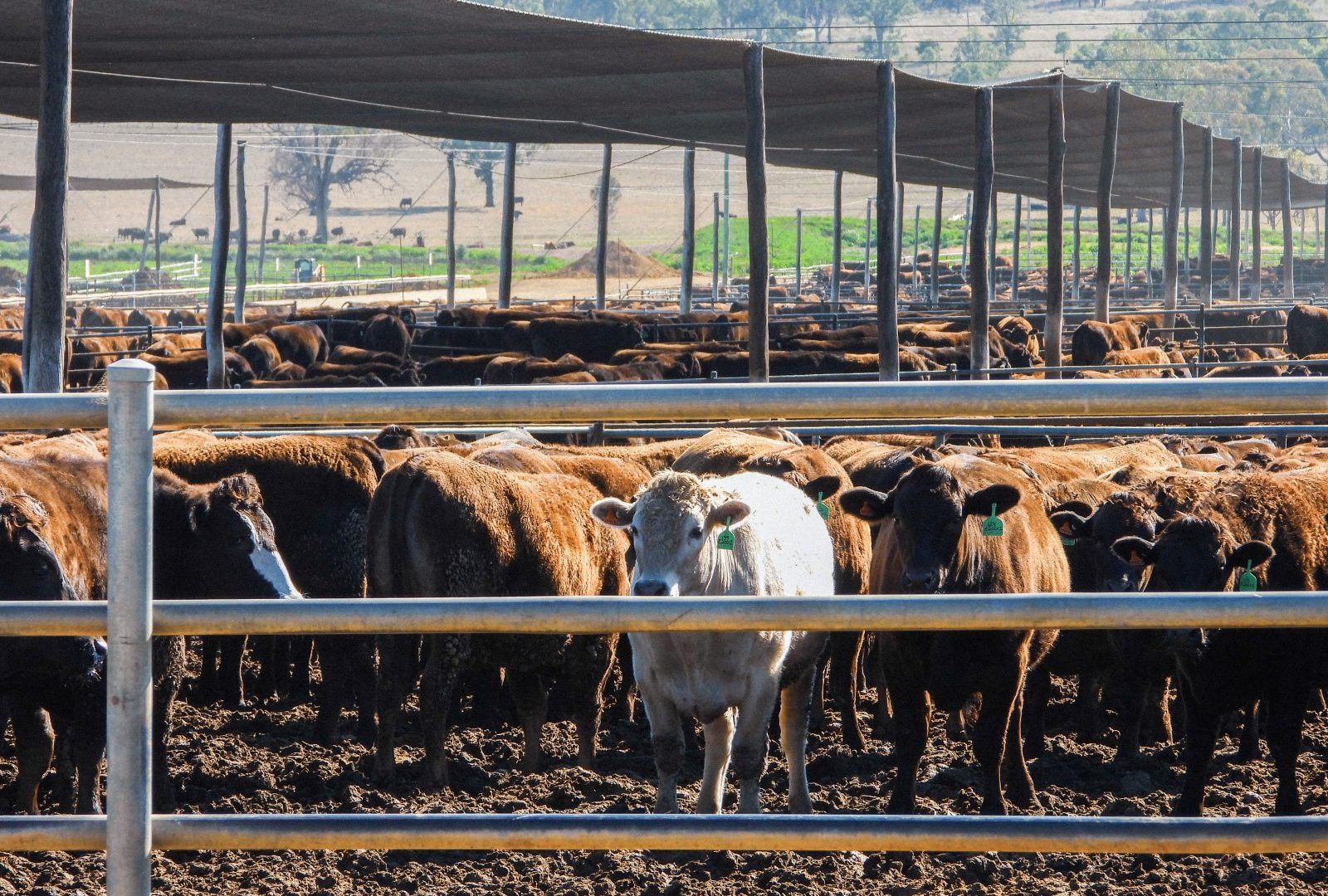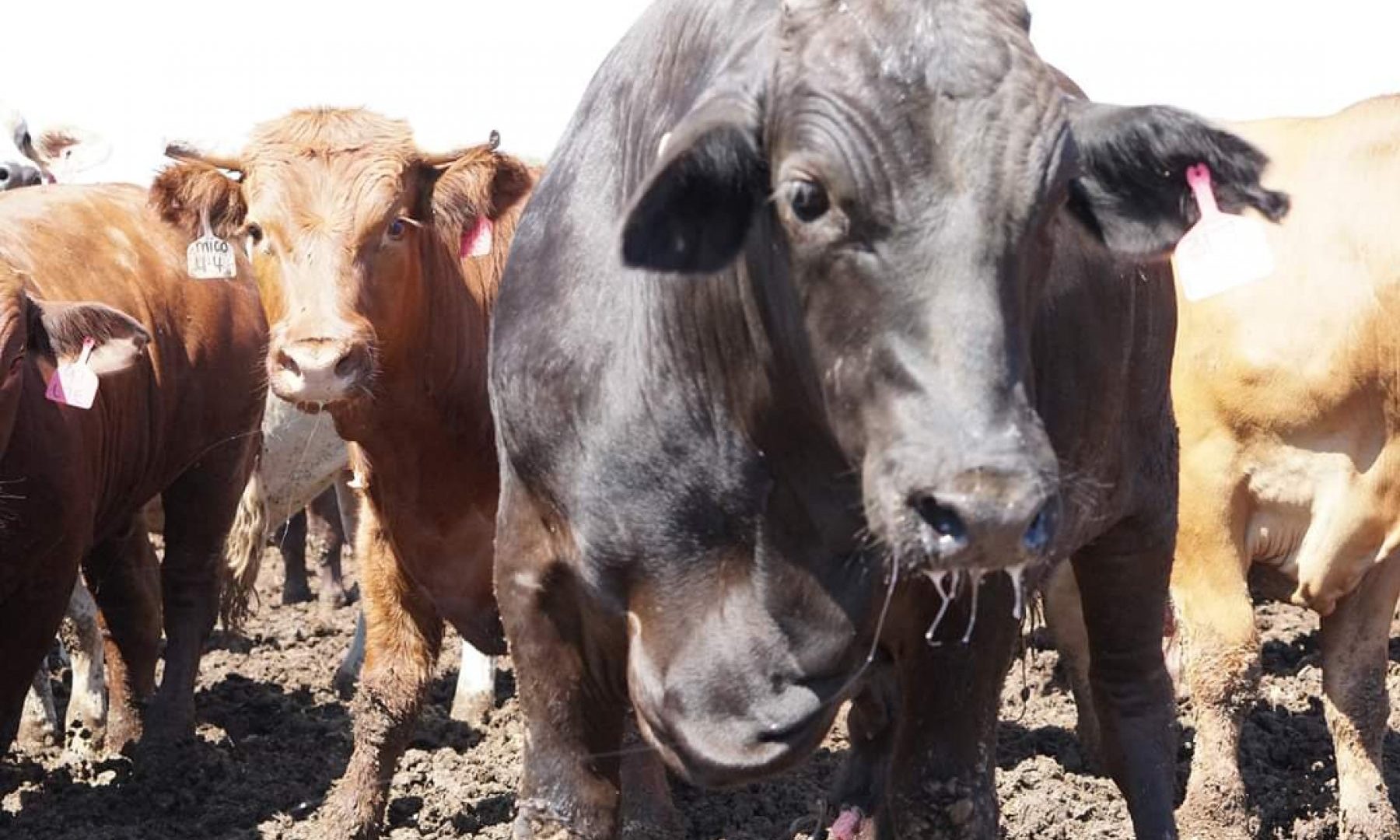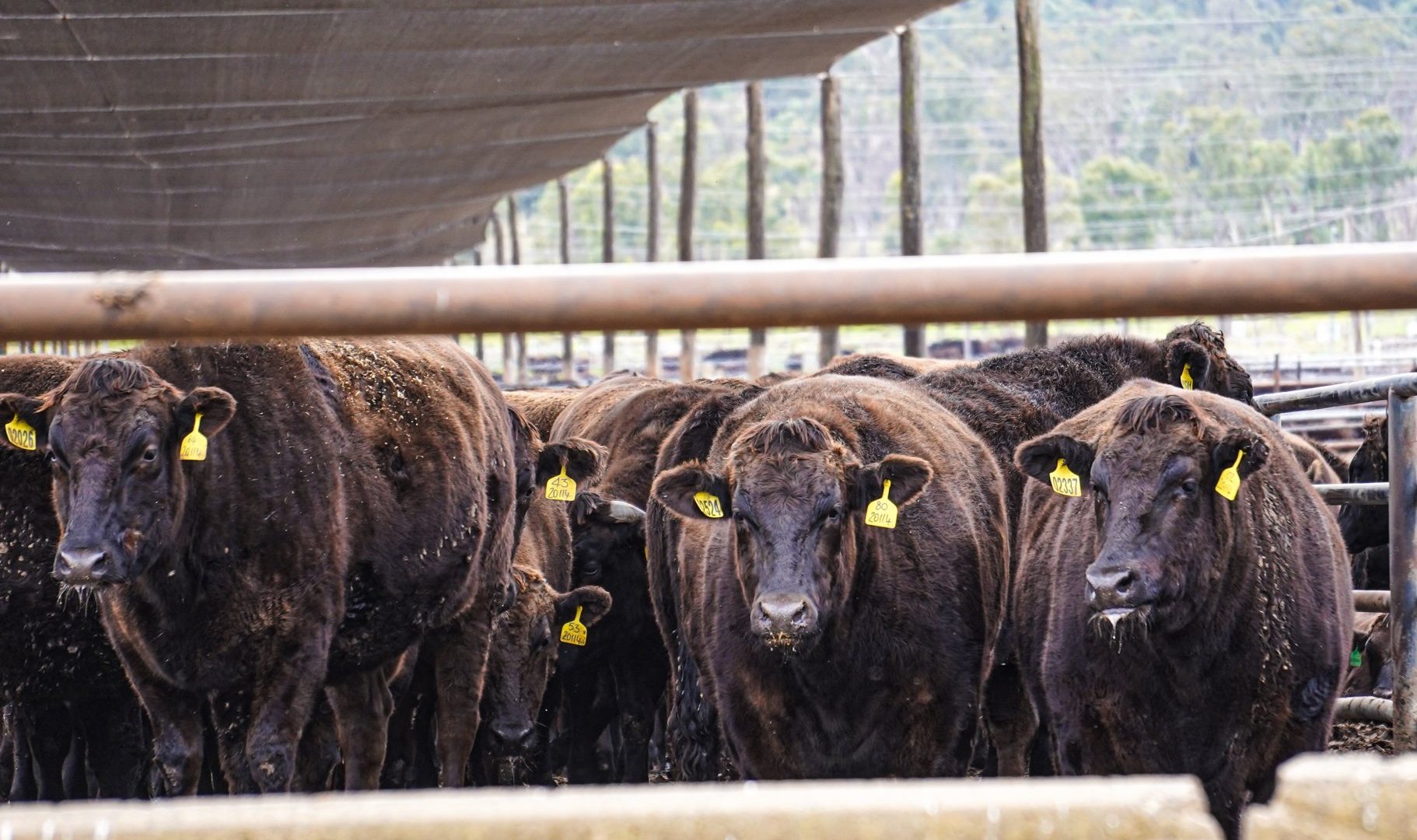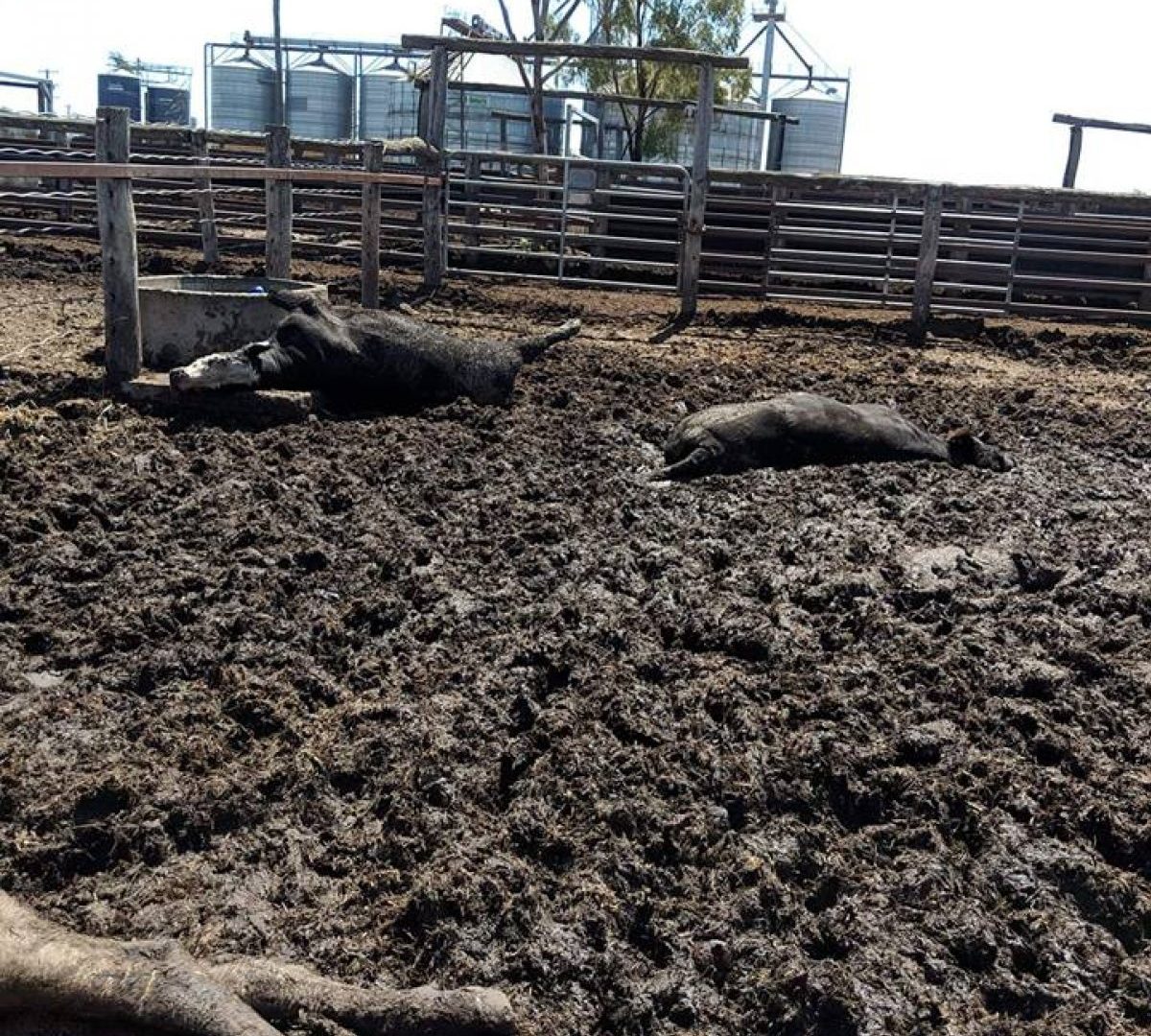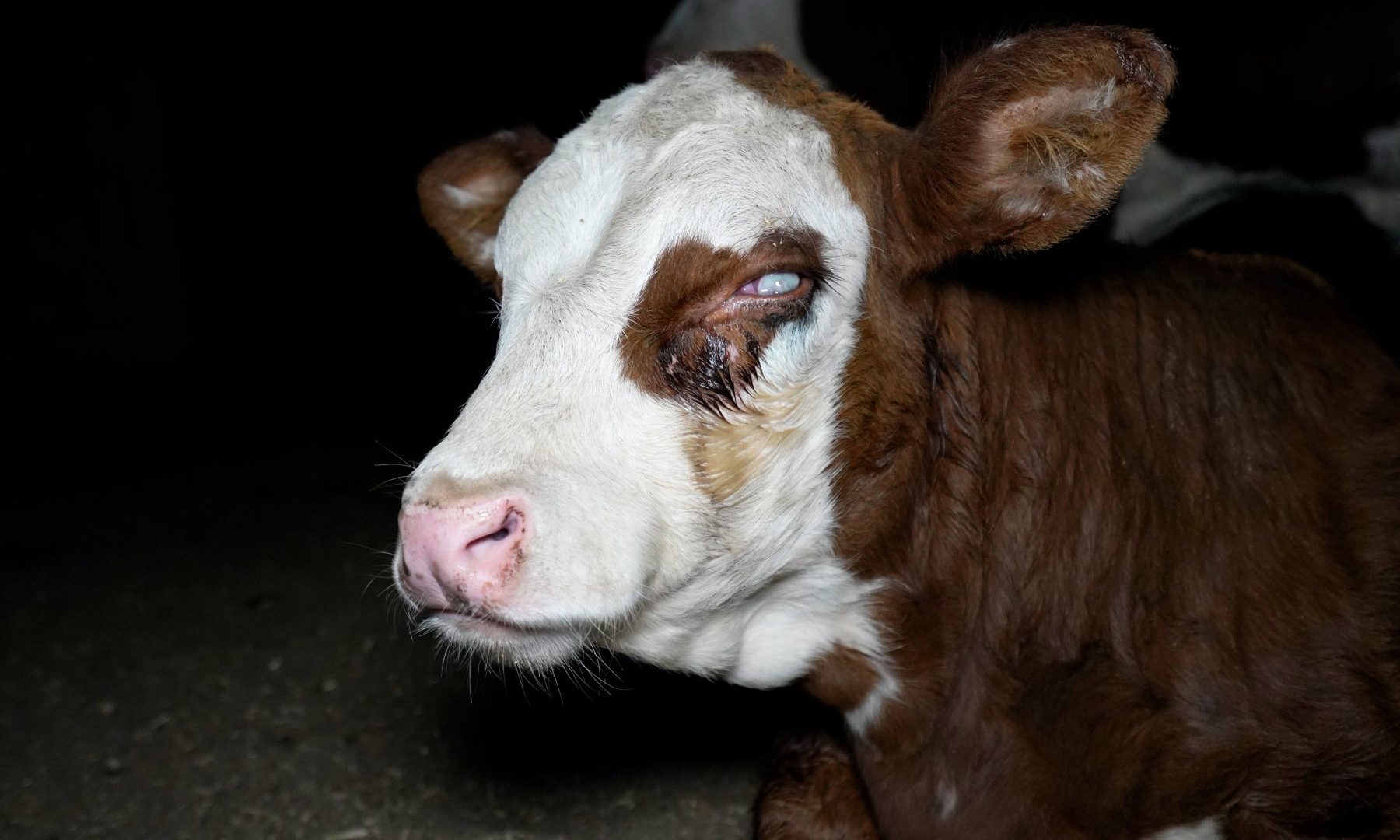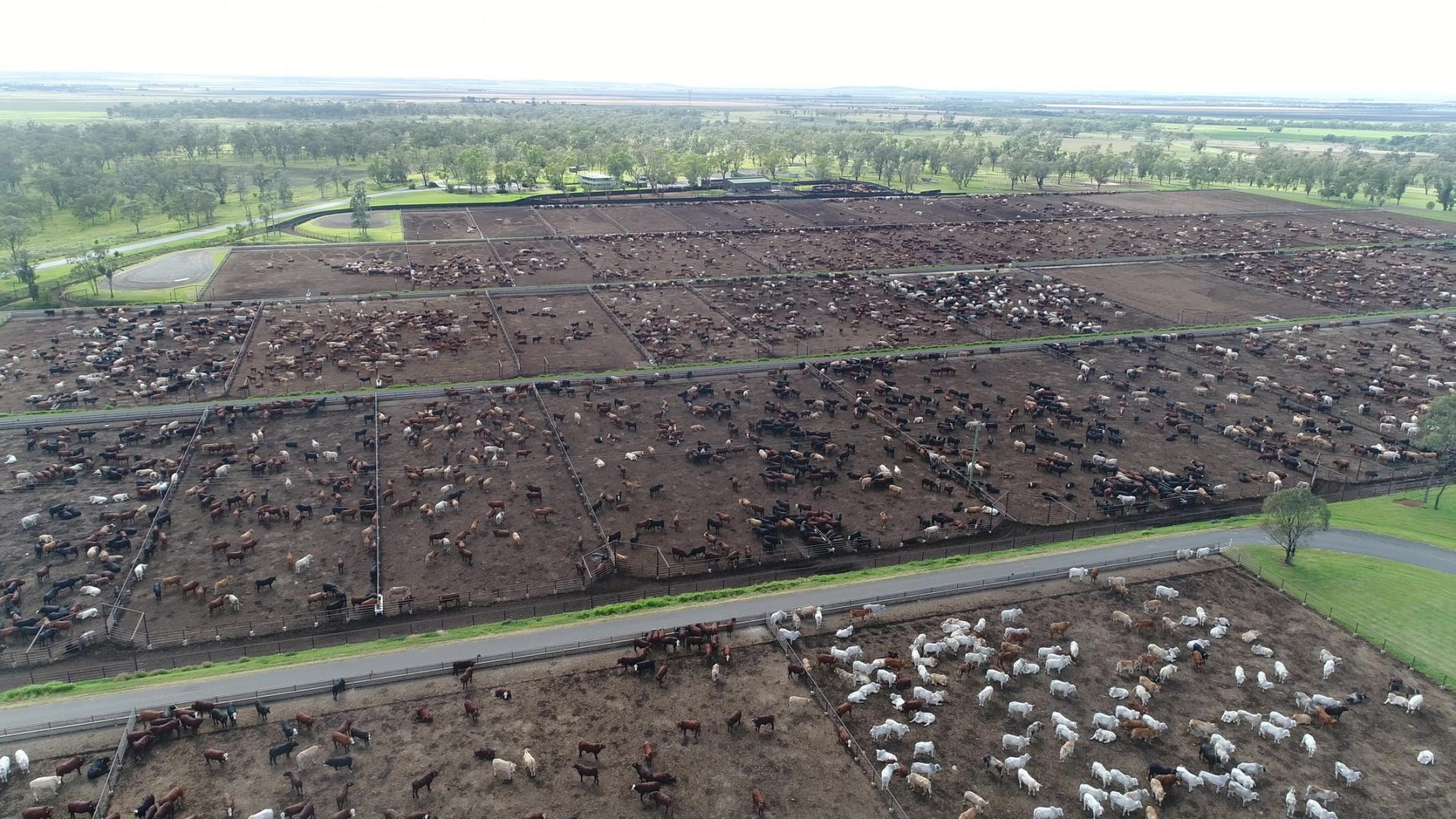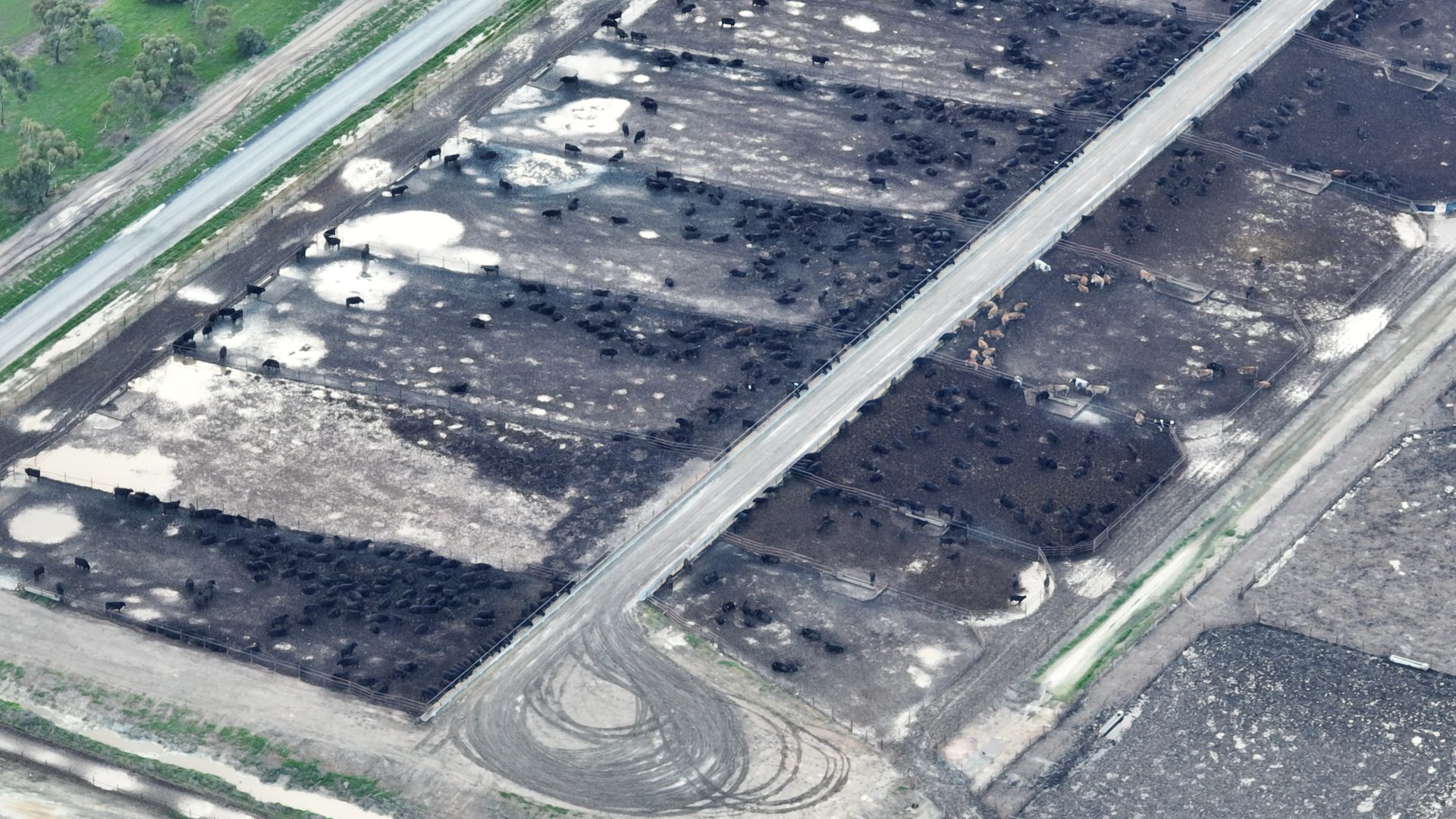Update: The public submission period has now ended. Thank you to all who took action. A decision is due to be made by the EPA in September 2023. In the meantime, please continue to speak out on behalf of farmed animals suffering in feedlots by sharing information on feedlots with your networks.
What comes to mind when you think of ‘feedlots’?
When you think of factory farming, chances are you picture hens in battery cages or pigs in sow stalls. But did you know that almost 80% of ‘beef’ products in Australian supermarkets come from intensively farmed cows? Controversial even within the agricultural sector, feedlots are a form of factory farming that deny animals expression of their natural behaviours in order to maximise profits. And they’re not just harmful to animals; they may also devastate the environment and pose great risks to human health.
What is a feedlot, exactly?
Feedlots are barren, dirty and stressful places for animals, and have damaging impacts on the mental and physical health of cattle. This farming system of penning animals outdoors often in close confinement, and feeding high protein grain-based diets, is used in ‘beef’ production to ensure animals reach a specific weight before slaughter. Prior to spending their last months or even up to a year within a feedlot, cattle have usually lived on grass pasture and had access to a more natural diet of grasses.
At the end of March 2022, there were 1,269,927 animals in around 400 feedlots in Australia.
Why do feedlots exist?
Feedlots exist in Australia for two main reasons – to more rapidly reach the sale weight of animals bred for their meat and to supplement pasture farming to meet consumer demand for meat products.
This image contains content which some may find confronting

What are the animal welfare issues with feedlots?
Feedlots do not allow cattle to express their natural behaviours, eat their natural foods, or find relief from extreme heat or cold. Confined in a feedlot, animals can often be unwell and stressed and are unable to have normal social interactions with one another, follow roaming instincts, and graze on a natural diet of grasses.
Conditions in feedlots mean animals commonly endure the following:
- Extreme heat stress and exposure to adverse weather such as wind, hail, heavy rain and storms. There is currently no legal requirement in Australia for feedlot operators to provide animals with shade and shelter.
- Exposure to disease as a result of standing in deep faeces and mud, and enduring cramped conditions.
- A strict grain-based diet with no access to their natural diet of grasses to maintain digestive health.
- Preventative over-use of antibiotics to reduce the risk of illness and ensure the survival of animals to slaughter weight in cramped and dirty conditions. A staggering 90% of animals in feedlots are put on antibiotics, making feedlots a significant contributor to antibiotic resistance in food systems.
- Use of growth hormone in some facilities to ensure cows reach slaughter weight in the fastest and most profitable time possible.
- Stress caused by cattle being mixed on arrival and new social hierarchies needing to be formed
- A high calf mortality rate: Whilst discouraged, calving in feedlots does happen. Giving birth in such unnatural environments is very stressful for cows, and also results in high death rates of their calves.
- A high likelihood of dead cows being left to rot within the feedlot pens, as timely clearing of bodies is a self-regulated process on large properties where many thousands of cows are closely confined.
- Inability to rest. Cattle need to lie down for up to 10 hours a day. In feedlots, they are often forced to lie on wet, muddy grounds covered in waste, preventing them from resting comfortably.
- Inability to have natural social interactions. Cattle arriving at a feedlot are mixed with unfamiliar animals and new hierarchies must be established, which can cause stress and injury from fighting.
How long are animals confined on feedlots in Australia?
The average length of time cattle are confined on feedlots is about 50 – 120 days. This is referred to as ‘grain fed’ on meat labels, or 30 days, which is called ‘grain finished’ on meat labels. However, depending on the reason they are sent to the feedlot, they can be confined for more than a year. In the case of the Harmony Feedlot at Gerang Gerung, animals are being grown and killed for ‘wagyu’ meat exported overseas and will be held at the feedlot for a minimum of 380 days before being slaughtered.
"Current feedlot environments are unable to meet the animal’s innate need to access pasture for grazing and for resting and lying, particularly at night."
This image contains content which some may find confronting

Feedlots are breeding grounds for disease and infection.
The transition to a grain-fed, intensive feedlot environment means animals are subjected to painful and potentially fatal health issues, including:
- Bovine Respiratory Disease – (BRD) is the most common cause of illness and death in Australian feedlot cattle, causing between 50% and 90% of all sicknesses and deaths. Animals often become sick with this disease when they first enter feedlots due to the unnatural and stressful conditions of moving from pasture to a crowded and unnatural environment. It is caused by stress triggered by things like injury, dehydration, young animals still weaning, transport and animals being introduced to others in crowded spaces.
- Acidosis – the primary cause of acidosis in cattle is feeding a high level of rapidly digestible carbohydrates, such as barley and other cereals – which make up part of feedlot cattle’s grain-fed diet.
- Liver abscesses – a painful condition that can cause severe depression in cattle, lead them to become anorexic, and left untreated will cause the animal to die a painful death from anaphylactic shock. The sheer number of animals confined in a feedlot means these issues often go unnoticed, with the animal suffering a miserable slow, and painful death.
- Botulism, E-Coli, foot rot and eye infections – bacterial infections caused when animals are left to stand in their own waste.
Feedlots present health risks for humans, too.
Widespread antibiotic use
Cattle in feedlots are fed antibiotics in order to try and avoid infection and disease and ensure the animals can reach slaughter weight and become profitable. A recent scientific research study found multi-antibiotic-resistant bacteria – or ‘superbugs’ – in 55% of ‘beef’ meat from samples sold in supermarkets in Australia due to the preventative use of antibiotics in intensive farms.
Use of growth hormones
Around 40% of Australian ‘beef’ cattle are also treated with growth hormones to increase their weight in a shorter period of time. While the use of growth hormones is still legal in Australia, it is banned in the EU and some Australian brands are moving away from the use due to increasing human health concerns.
Q Fever
Q fever (C. burnetii) is the most commonly reported zoonotic disease in Australia and occurs mostly in regional areas where individuals and communities are working or living near abattoirs, sale yards and feedlots. It is transmitted most commonly through direct contact with effluent at feedlot effluent, manure or compost pits or through contaminated airborne particles in the atmosphere or on work clothes.
Feedlots are an environmental disaster.
Feedlots contribute to air and water pollution and use vast expanses of land, which is aggressively cleared and maintained as dirt. Some of the key environmental concerns around the development and expansion of feedlots are:
- Land clearing to make way for feedlots – this contributes to climate change, ocean acidification, and threatens the survival of native species. Australia is the only country in the developed world listed as a deforestation hotspot, with habitat destruction making us world leaders in rapid rates of species extinction.
- Rainfall run-off causes feed, faeces, antibiotic use, and bacteria from feedlots to pollute local rivers, waterways, and catchment systems. This causes causing ocean acidification, mass fish deaths and poor water quality.
- Composting of dead bodies called ‘mortality composting’ is standard practice for the industry. This consists of large areas where the remains of dead animals are covered with tarpaulins or left to decompose in the ground. This can impact groundwater run-off and soil quality and transmit disease.
- Mass broadacre cropping of grain to feed the cattle in feedlots further contributes to deforestation, habitat destruction, and native species extinction in Australia.
Making your submission about the proposed Harmony Feedlot expansion.
The Government submission site provides a simple survey.
The agency seeking feedback is the Environmental Protection Agency of Victoria, and they are seeking feedback specifically about the environmental and community impacts of the proposed feedlot expansion. Please make sure that your submission focuses on these areas. You can of course attach additional information on the welfare implications of feedlots on animals.
Please ensure that you write your submission in your own words for it to carry maximum impact.
If you need any assistance with your submission, please reach out to our friendly team on 03 9329 6333.



